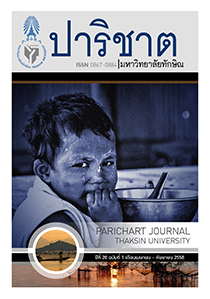A Study of The Usage and The Need of TheInternet for Teaching- Learning Kanji at Undergraduate Level
Main Article Content
Abstract
การศึกษาครั้งนี้มีวัตถุประสงค์เพื่อสำรวจและวิเคราะห์รูปแบบสื่อ อินเทอร์เน็ตเพื่อการเรียนการสอนอักษรคันจิที่มีอยู่ในปัจจุบัน สำรวจสภาพการ ใช้สื่ออินเทอร์เน็ตในการเรียนการสอนอักษรคันจิ และสำรวจความต้องการใช้สื่อ อินเทอร์เน็ตในการเรียนการสอนอักษรคันจิของผู้เรียนและผู้สอนระดับอุดมศึกษา โดยจากการสำรวจเว็บไซต์การเรียนการสอนอักษรคันจิ เมื่อจำแนกตามเนื้อหา ความยากง่ายเป็นระดับ 3 ระดับคือ 1) ระดับต้น 2) ระดับกลาง และ 3) ระดับสูง พบว่าเป็นเว็บไซต์สำหรับผ้เูรียนระดับต้นมากที่สุดและจำแนกตามรปูแบบเนื้อหา อักษรคันจิได้ 5 รูปแบบ คือ 1) เสียงอ่าน 2) ความหมาย และ 3) รูปของอักษรคันจิ 4) ที่มาของอักษรอักษรคันจิและ 5) วิธีใช้ พบเนื้อหาด้านเสียงอ่านอักษรคันจิมาก ที่สุด สำหรับการสำรวจสภาพการใช้สื่ออินเทอร์เน็ตในการเรียนการสอนอักษร คันจิ และความต้องการใช้สื่ออินเทอร์เน็ตในการเรียนการสอนอักษรคันจิของ ผู้เรียนและผู้สอนในระดับอุดมศึกษาโดยกลุ่มตัวอย่างทศึกษาคืออาจารย์และนิสิต นักศึกษาจำนวน 348 คน พบว่า ผู้สอนร้อยละ 80 ใช้สื่ออินเทอร์เน็ตในการเรียน การสอนอักษรคันจิสำหรับผู้เรียนมการใช้สื่ออินเทอร์เน็ตในการเรียนอักษรคันจิ ร้อยละ 58.43 เหตุผลที่ผู้สอนส่วนใหญ่เลือกใช้สื่ออินเทอร์เน็ตในการสอนอักษร คันจิ คือ มีตัวอย่างคำศัพท์ อักษรคันจิจำนวนมาก และมีแบบฝึกหัดให้ผู้เรียนได้ ฝึกฝน ส่วนเหตุผลที่ผู้เรียนเลือกใช้สื่ออินเทอร์เน็ตในการเรียนอักษรคันจิ เพราะ เป็นสื่อการสอนที่สะดวก สามารถเข้าถึงได้จากคอมพิวเตอร์ แท็บเล็ต มือถือ และ มีตัวอย่างคำศัพท์อักษรคันจิจำนวนมาก สำหรับผลการสำรวจความต้องการใช้ สื่ออินเทอร์เน็ตในการเรียนการสอนอักษรคันจิของผู้เรียนและผู้สอนในระดับ อุดมศึกษา พบว่า ผู้สอนส่วนใหญ่มีความต้องการสื่ออินเทอร์เน็ตที่ใช้ในการเรียน การสอนอักษรคันจิที่แสดงรากศัพท์ของอักษรอักษรคันจิ (部首:bushu) มากทที่สุดรองลงมาคือแสดงเสียงอ่านอักษรคันจิ (読み:yomi) ผู้เรียนส่วนใหญ่ ในทุกชั้นปีมีความต้องการสื่ออินเทอร์เน็ตที่ให้ข้อมูลเกี่ยวกับการเรียนการสอนอักษรคันจิเหมือนกัน คือ แสดงเสียงอ่านอักษรคันจิ (読み:yomi) รองลงมา คือ แสดงเสียงอ่านอักษรคันจิแบบเสียงญี่ปุ่น (訓読み:kun-yomi) และเสียงอ่านแบบจนี (音読み:on-yomi) อย่างชัดเจน และแสดงความหมายเป็นภาษาไทย
A Study of The Usage and The Need of The Internet for Teaching- Learning Kanji at Undergraduate Level
Sirinya Piaklin
The present study has been conducted with the major aims to 1) survey and analyze internet media for teaching – learning Kanji, 2) survey the use of internet media for teaching – learning Kanji by university students and instructors, and 3) survey needs of university students and instructors concerning the use of internet media for teaching – learning Kanji. According to the survey 24 selected Kanji lesson websites were categorized regarding difficulty level as follows; 1) websites for beginner 2) websites for intermediate learners, and 3) websites for advance learners. In addition it has been found the majority of selected Kanji lesson websites covering lessons for beginners. Regarding the content of the websites it can be categorized into 4 groups as follows; 1) pronunciation 2) meaning 3) character shape of Kanji 4) origins of Kanji 5) the usage. It also has been found that the most of the selected teaching – learning Kanji websites covering pronunciation content. The sampling of the need analysis survey consisted of university students and instructor in total of 348 people. Regarding the survey findings it has been found that 80 % of instructors use internet media while 58.43 % of students use internet media to support their learning. The high percentage of instructors using internet media for Kanji lesson is due to a variety of example Kanji vocabulary and exercises. While students regard internet media as a convenient source providing various example of Kanji vocabulary that they can access via computer, tablet and mobile phone. Regarding the survey concerning needs of instructors, internet media for Kanji lesson has been found to be highly needed. Internet media for Kanji lesson with radical (Bushu) appear to be highly needed, respectively followed by the website with Kanji pronunciation. In addition the survey concerning students’ needs reveals that internet media for Kanji lesson also has been found to be highly needed. Internet media for Kanji lesson with radical (Bushu) is also regarded as highly needed, respectively followed by Kun-yomi, On-yomi, and with meaning explanation in Thai.


